
How to Use LM335 Temp Sensor: Examples, Pinouts, and Specs
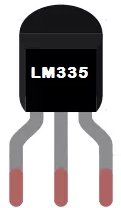
 Design with LM335 Temp Sensor in Cirkit Designer
Design with LM335 Temp Sensor in Cirkit DesignerIntroduction
The LM335 is a precision temperature sensor designed to provide an output voltage directly proportional to the absolute temperature in Kelvin. With its linear output and high accuracy, the LM335 is ideal for a variety of temperature measurement and control applications. It operates over a wide temperature range, making it suitable for industrial, scientific, and consumer applications.
Explore Projects Built with LM335 Temp Sensor
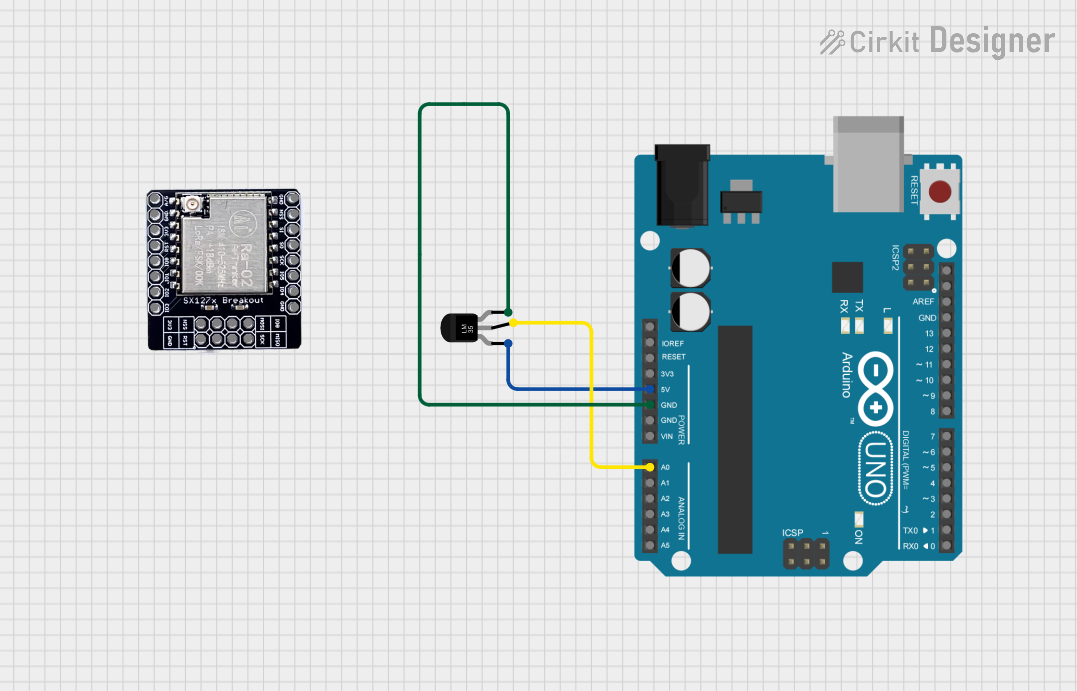
 Open Project in Cirkit Designer
Open Project in Cirkit Designer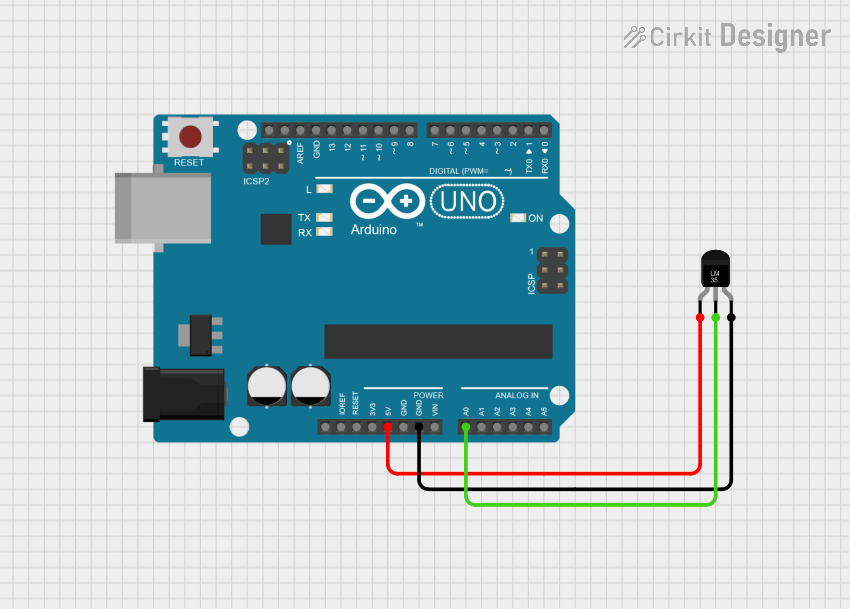
 Open Project in Cirkit Designer
Open Project in Cirkit Designer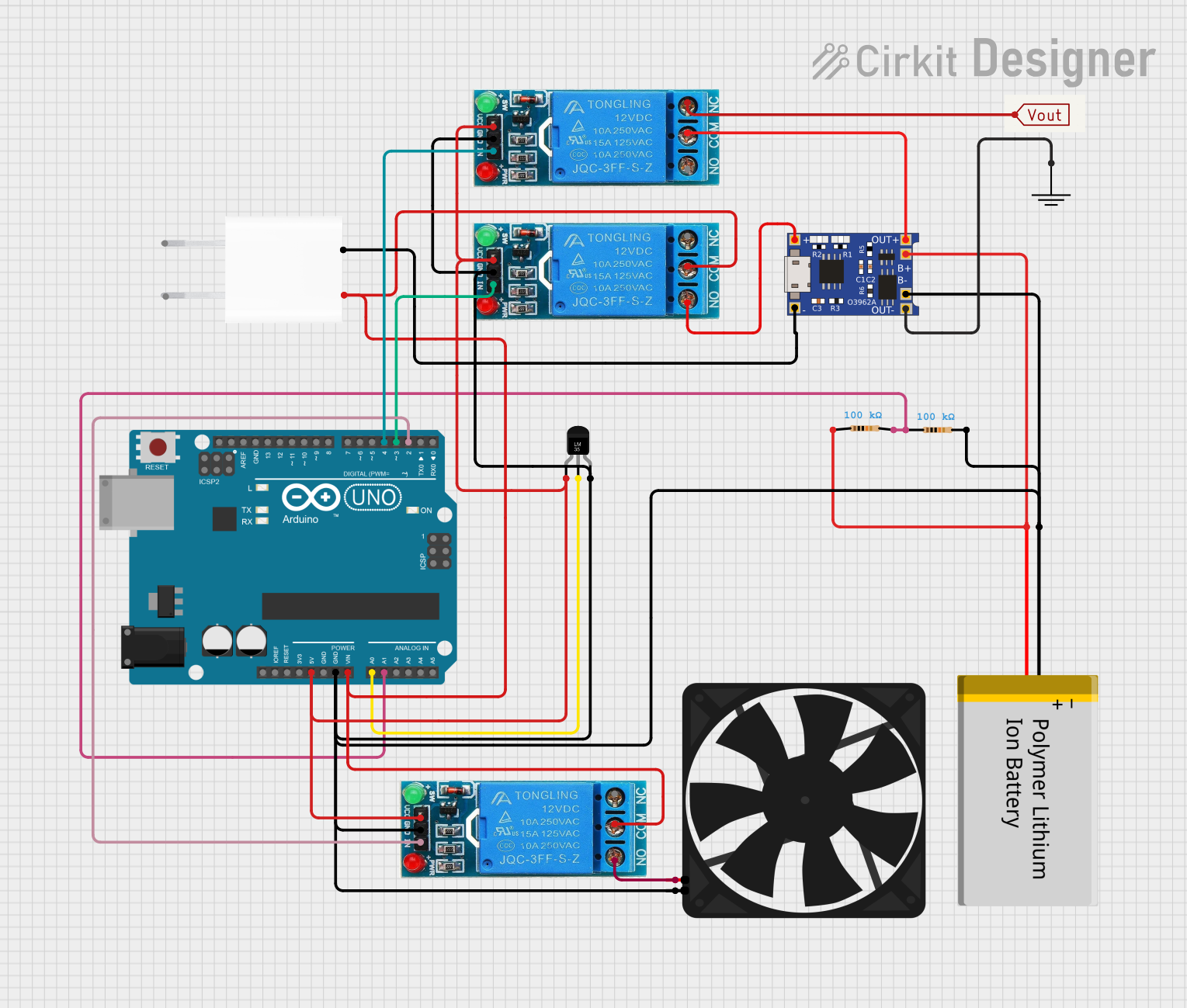
 Open Project in Cirkit Designer
Open Project in Cirkit Designer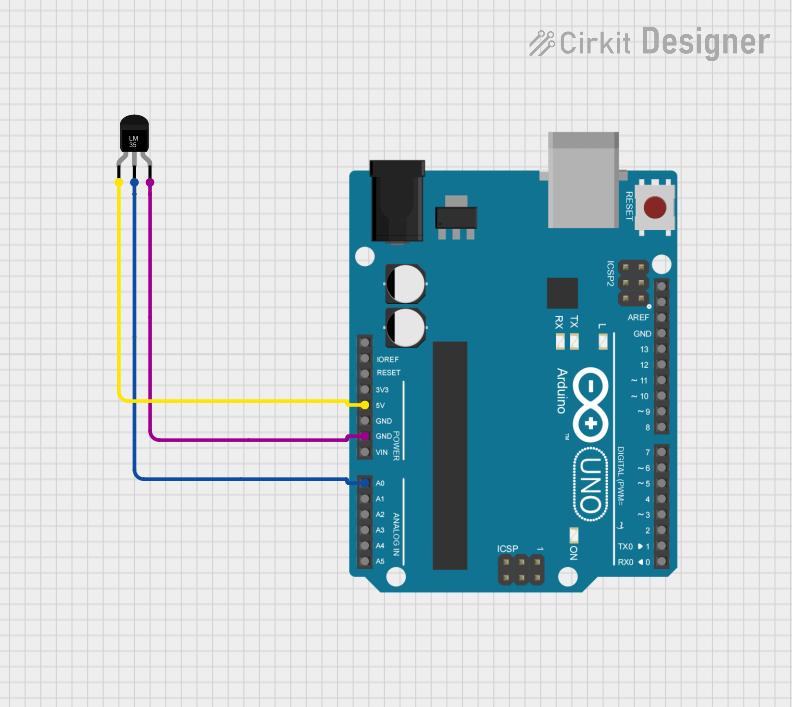
 Open Project in Cirkit Designer
Open Project in Cirkit DesignerExplore Projects Built with LM335 Temp Sensor

 Open Project in Cirkit Designer
Open Project in Cirkit Designer
 Open Project in Cirkit Designer
Open Project in Cirkit Designer
 Open Project in Cirkit Designer
Open Project in Cirkit Designer
 Open Project in Cirkit Designer
Open Project in Cirkit DesignerCommon Applications
- HVAC systems for temperature monitoring and control
- Weather stations and environmental monitoring
- Industrial process control
- Consumer electronics requiring temperature sensing
- Laboratory-grade temperature measurement systems
Technical Specifications
The LM335 is a versatile and reliable temperature sensor. Below are its key technical specifications:
| Parameter | Value |
|---|---|
| Operating Voltage Range | 2.7V to 40V |
| Output Voltage Range | 2.98V at 25°C (298K) |
| Temperature Range | -40°C to +100°C |
| Temperature Coefficient | 10mV/K |
| Accuracy | ±1°C (typical) |
| Output Impedance | 0.6Ω |
| Calibration | Adjustable via external resistor |
| Package Types | TO-92, SOIC-8 |
Pin Configuration
The LM335 is typically available in a 3-pin TO-92 package. Below is the pinout description:
| Pin | Name | Description |
|---|---|---|
| 1 | V+ | Positive supply voltage |
| 2 | GND | Ground connection |
| 3 | VOUT | Output voltage proportional to temperature in Kelvin |
Usage Instructions
The LM335 is straightforward to use in temperature sensing applications. Below are the steps and considerations for integrating it into a circuit:
Basic Circuit Connection
- Power Supply: Connect the V+ pin to a DC voltage source (2.7V to 40V). Ensure the supply voltage is stable.
- Ground: Connect the GND pin to the ground of the circuit.
- Output: The VOUT pin provides a voltage proportional to the temperature in Kelvin. For example, at 25°C (298K), the output voltage will be approximately 2.98V.
Calibration
- To improve accuracy, you can calibrate the LM335 using an external resistor (typically a 5kΩ potentiometer) connected between the VOUT pin and the V+ pin. Adjust the potentiometer to fine-tune the output voltage.
Important Considerations
- Bypass Capacitor: Place a 0.1µF capacitor between V+ and GND to filter noise and improve stability.
- Temperature Conversion: The LM335 outputs temperature in Kelvin. To convert to Celsius, use the formula: [ T_{Celsius} = V_{OUT} - 2.73 ] where ( V_{OUT} ) is in volts.
- Arduino Compatibility: The LM335 can be interfaced with an Arduino for digital temperature monitoring.
Example: Connecting LM335 to Arduino UNO
Below is an example of how to connect the LM335 to an Arduino UNO and read temperature data:
Circuit Diagram
- Connect the V+ pin of the LM335 to the 5V pin of the Arduino.
- Connect the GND pin of the LM335 to the GND pin of the Arduino.
- Connect the VOUT pin of the LM335 to an analog input pin (e.g., A0) on the Arduino.
Arduino Code
// LM335 Temperature Sensor Example
// Reads temperature in Kelvin and converts to Celsius
const int sensorPin = A0; // LM335 output connected to analog pin A0
const float voltageRef = 5.0; // Reference voltage of Arduino (5V)
void setup() {
Serial.begin(9600); // Initialize serial communication
}
void loop() {
int sensorValue = analogRead(sensorPin); // Read analog value from LM335
float voltage = (sensorValue / 1023.0) * voltageRef; // Convert to voltage
float temperatureK = voltage * 100.0; // Convert voltage to Kelvin
float temperatureC = temperatureK - 273.15; // Convert Kelvin to Celsius
// Print temperature readings to Serial Monitor
Serial.print("Temperature in Kelvin: ");
Serial.print(temperatureK);
Serial.print(" K, Celsius: ");
Serial.print(temperatureC);
Serial.println(" °C");
delay(1000); // Wait 1 second before next reading
}
Best Practices
- Avoid exposing the LM335 to temperatures beyond its specified range (-40°C to +100°C).
- Use proper decoupling capacitors to minimize noise in the output signal.
- For long-distance connections, shielded cables are recommended to reduce interference.
Troubleshooting and FAQs
Common Issues and Solutions
No Output Voltage:
- Check the power supply connections and ensure the input voltage is within the specified range.
- Verify that the GND pin is properly connected to the circuit ground.
Inaccurate Temperature Readings:
- Ensure the sensor is calibrated using an external resistor.
- Check for noise in the power supply and add a bypass capacitor if necessary.
- Verify that the sensor is not exposed to rapid temperature changes or external heat sources.
Fluctuating Output:
- Add a 0.1µF capacitor between V+ and GND to stabilize the output.
- Ensure the sensor is not placed near high-frequency noise sources.
FAQs
Q: Can the LM335 measure negative temperatures?
A: Yes, the LM335 can measure temperatures below 0°C. The output voltage will still be proportional to the absolute temperature in Kelvin.
Q: How do I convert the output voltage to Fahrenheit?
A: First, convert the voltage to Celsius using the formula ( T_{Celsius} = V_{OUT} - 2.73 ). Then, convert Celsius to Fahrenheit using ( T_{Fahrenheit} = (T_{Celsius} \times 9/5) + 32 ).
Q: Can I use the LM335 with a 3.3V microcontroller?
A: Yes, the LM335 can operate with a supply voltage as low as 2.7V, making it compatible with 3.3V systems.
Q: Is the LM335 waterproof?
A: No, the LM335 is not waterproof. If you need to use it in wet environments, consider encasing it in a waterproof housing.
By following this documentation, you can effectively integrate the LM335 temperature sensor into your projects and achieve accurate temperature measurements.